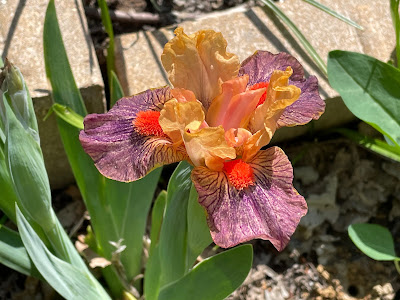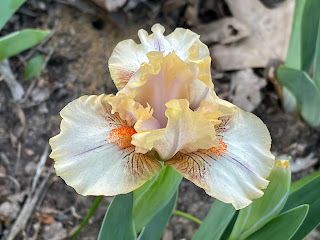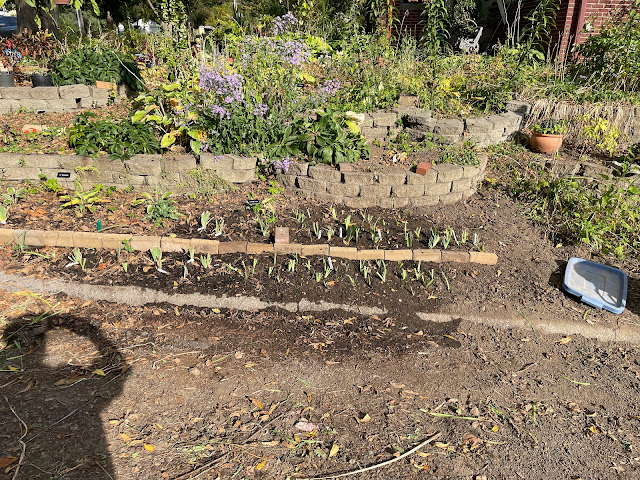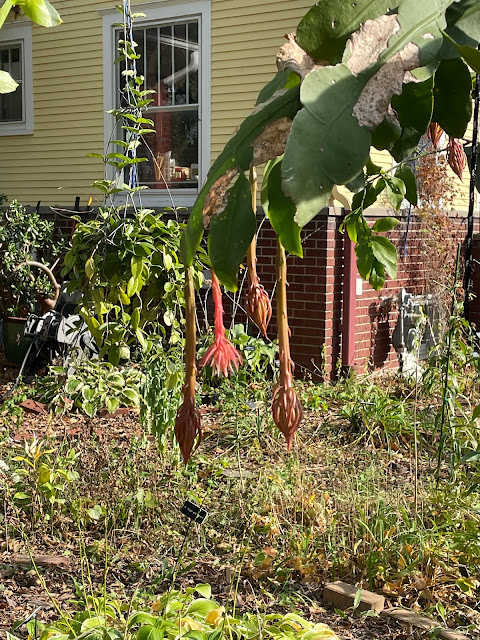The garden is very much like life.
There is the past, the present, and the future.
Each is important.
It is all about finding the balance between the three.
It is also about moving from one to the other.
That would be transition time.
The past is like pieces of a puzzle.
That puzzle is who we are, here in the present.
The present is sort of elastic. It can be a brief moment, like just here in the dark on a Tuesday morning, before any hint of sunrise.
Or it can be this week, long before any frost is forecast.
Then there is the future. Oh my. What a topic. Is the future just what happens later at work today?
Or is the future the winter?
Or the spring?
Enough of that.
As I sit in the dark early in thew week I think about my garden to-do list.
That list requires jumping around between the past and the future.
What plants are new and therefore need labels?
What bulbs need to be purchased for planting this fall?
Planting bulbs is all about doing something in the present for future enjoyment.
Just imagine for the moment what commitment you have to have to plant a tree? Or tree peony seeds.
I begin to think about bringing plants inside.
This is called the great plant migration.
Plants will come inside both to the house and to the office.
I try to do a little inventory to allow me to see the number and type of plants that have to move.
Update Saturday afternoon:
I ordered those bulbs that had not been ordered. Monsella tulips were on that list. I have more tulips coming in the next month than usual.
Still coming are more martagon lilies.
And Oriental poppies.
And some more things I am forgetting.
But for the moment I am planting for the future with little bearded iris.
First of all here were some of the stars from early May.
How can you not get them all on the "more" list.
I was so inspired by those plants in May that I ordered about 16 new plants from Aitkins, in Portland, Oregon. That is where I have gotten most of my little iris.
I was just finishing planting those a week ago when a friend from Lisbon started sending me many of her little ones. She was apparently thinning hers. Iris do tend not to be divided in years. And then you must divide and figure out what to do with so many.
So I got about a dozen new varieties. There were 3-4 of some varieties, and lots more of others.
This is blueberry tart. I think I planted a special snowdrop called blueberry tart. I sometimes think about planting plants with the same name all in one spot. Remember Shirley? There are tulips and there are poppies.
I was running out of room to plant 50-100 new little iris.
So I began to redo the bed along Fairview which had some iris. It was rather overgrown, not really having been worked on in a while. Did I mention it still has not rained? The ground was rather hard. I call this resetting a bed. You have a whole lot to do before any plants go in the ground.
I use the shovel or the spade to turn over a clump. When it is so dry I have to hit the clump with the flat side of the shovel, trying to break up the clumps. After all the salvageable plants are removed I work the dirt adding compost and a little horse manure. Finally I rake the little bed, getting out all the little roots of plants that had been removed. At some point the reward and easy part is planting the iris.
Here is how far I got yesterday.
Elsewhere in the garden the fall bloom continued.
Having repeated this several times recently, let me say again this is Epiphyllum hookeri. It will set buds all the way to frost. I have seen some that yesterday were visible but no more than1/2 inch. Maybe they will bloom if we have a late frost.
This next picture is Epiphyllum oxypetulum. 5 of the 7 buds are continuing to mature. The one that ha turned red had something happen so it did not mature. The buds are now about 8 inches long. You can tell when they are about 2 days from blooming when they begin to curve up. That hasn't happened yet.
The toad lilies are now all blooming.
Julia's recipe
Chicken and chips - chilaquiles in tomatillo sauce
I watched an episode of Simply Ming in which Rick Bayless was the guest chef, and he made chilaquiles. I have come to learn that the term "chilaquiles" covers a whole spectrum of dishes, always including tortilla chips or strips and always including a sauce of some kind, but otherwise anything goes. Meat, no meat; eggs, no eggs; cheese, no cheese; red sauce, green sauce; lots of toppings or not. Here is my inauthentic version.
In the bowl with garnishes. It's a pretty dish. We served it with corn from our freezer (farmer's market corn), salad and cantaloupe.
Leftovers were good warm or cold.
Odds and Ends
A word from Julia about apples.
One of our favorite vendors at the Farmer's Market is Buffalo Ridge Orchard, located near Central City, north and east of Cedar Rapids. They sell beautiful lettuce in the spring, little potatoes, beets, tomatoes, kale later on.
And apples of all kinds. I buy Lodi in the early summer for pies and applesauce. Then we browse among the varieties for old favorites and new favorites. Today I was taken with Wolf River. I made apple crisp with the apple on the right - it yielded 8 cups of pared and cored and sliced apple bits, crisp and tart-ish. One apple. The little item in the foreground is an egg. An extra large egg at that. Apples from the Farmer's Market, wherever you are, will be much fresher than the ones that travel from Michigan or Washington. And the varieties! Silken and Orleans Antique and Song of September and Zestar. And Wolf River. Find some local apples if you can.






























1 comment:
Oh, the color of that cactus flower! Sort of pearly pink/violet. Ravishing. And Julia--you're so right about local apples.
When we first moved to CT we planted an apple orchard. But the landscaper was irresponsible and threw out all the identity tags, so we had a dozen apple trees and no idea what they were. There was a family that had been in town, farmers, for 250 years, and operated a farm market selling their own produce, including MANY kinds of apples. I mentioned to Howie (owner) that we had unidentifiable apple trees, and he said if we brought him an apple from each one he would identify it. So we did. When there were apples ,we picked one from each tree and took it to Howie. He sat down at a table, got out his pocket knife, cut a slice of each one, ate it, and told us what variety it was--from its texture and flavor.
He grew wonderful apples, including a yellow Japanese variety that was HUGE, like one of your bigger grapefruit. Very sweet. Can't think of the name, but it'll come to me!
Post a Comment